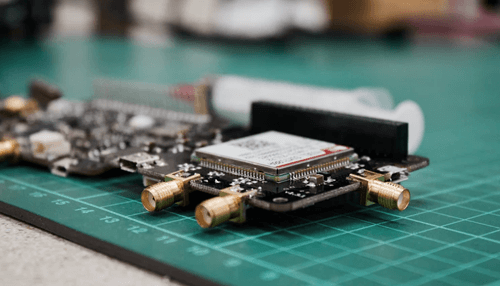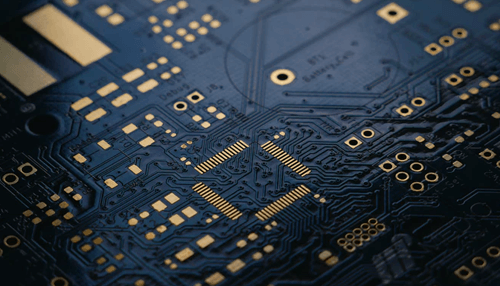Traditionally, you need at least an undergraduate degree in order to break into electrical engineering. However, with direct to consumer printed circuit board ordering, often referred to as D2C PCB ordering, there are less barriers to learning electrical engineering than ever before. Students, hobbyists, recent graduates and engineering veterans are all excited about the new breakthroughs and opportunities the D2C PCB industry is providing. With costs continuing to lower and technology steadily advancing, access to electrical engineering and printed circuit boards is no longer limited to industry professionals.
No More Brokers
In the past, going through printed circuit board brokers was the only way to create a custom circuit board order, in no small part due to a language barrier that was created when most manufacturers moved overseas. This meant that there were large minimum orders, extra fees, and extended wait times.
As the manufacturing processes advanced, printed circuit boards became more sophisticated and cheaper than ever to produce. This allowed many PCB companies to develop all over the world in countries where it had previously been too expensive to produce printed circuit boards. The industry’s expansion, along with the introduction of translation softwares and online ordering options eliminated the need for middlemen. Since brokers were no longer necessary, PCB costs were driven down even further.
Software Allows Consumers to Easily Create Circuits in a Virtual Environment
With the advent of softwares that allowed anyone to quickly and easily create and simulate circuits and schematics, the world of electrical engineering was opened up to an entirely new audience. Whereas in the past, designing circuits and creating printed circuit boards required an extensive post-secondary education, these new softwares allow people without access to such an education to learn about circuit theory and quickly spot mistakes. Once someone becomes fluent in the various printed circuit board design softwares, they are able to design and order printed circuit boards for their projects, regardless of their educational background.
Low Volume Capabilities and D2C PCB Ordering
In recent years, it has become possible to order low volumes of direct to consumer printed circuit boards. With this option, people who couldn’t afford to place a large PCB order can now create prototypes that weren’t able to come to fruition in the past. This meant that innovative new products and ideas began to hit the market in the last decade in a way that was completely unexpected. In the past, you had to pitch your idea to large manufacturing companies, or have an immense amount of capital to launch a new product. Today, new prototypes and product lines are constantly being developed and introduced by entrepreneurs who are utilizing D2C PCB ordering.
Learning From Home With D2C PCB Ordering
The number of people educating themselves from home has skyrocketed. Direct to consumer PCB ordering facilitates their needs by allowing them to easily and affordably learn about electronics and engineering. Since D2C PCB ordering is open to anyone, educational and economic barriers have largely been eliminated.
Printed circuit boards are used in a huge number of electronic projects, from popular space and aerial technology prototypes, to AI and robotics. Open-source projects and free classes are increasing available, making engineering and learning from home even more fun and accessible. With the rapidly growing community of makers, there has been an influx of innovation seen not only in new designs but throughout the industry.
The Cost of Printed Circuit Boards Has Dropped Considerably
Before direct to consumer printed circuit board ordering was available, the cost of ordering a small number of PCBs was astronomical. Not only that, many brokers had minimum order requirements and only worked with large companies, so it could be difficult to source a quality product even if you had access to the amount of money necessary to make such a request. However, now that the manufacturing process allows for small numbers of printed circuit boards to be produced at a reasonable price, students and hobbyists are able to access technology that was out of reach just years ago.
Creating prototypes has never been so easy and affordable. This is exciting not only for those people who are gaining access to ordering printed circuit boards but also the industry as a whole. When more people are able to develop their ideas, it leads to faster advancement in both design and technology.
PCB Technology Continues to Advance
Exciting developments have been continuing in the printed circuit board industry. New technologies and PCB capabilities are being constantly introduced as prices continue to drop. With advancements such as new board materials that allow for extreme temperature fluctuations, impact resistance, and flexibility, PCBs are able to adapt to a wide range of needs for a huge number of uses. Printed circuit boards also continue to get smaller, and with new advancements in High-Density Interconnect (HDI) technology, we should see the trend continue.
Anyone who has an interest in or passion for electrical engineering, tinkering or inventing is now able to order a small number of custom printed circuit boards for their projects. Printed circuit boards are a great way to learn about electronics and engineering with a low cost barrier, and a growing volume of online learning resources. The ever-increasing number of people educating themselves at home by utilizing D2C PCB ordering is already beginning to create an exciting new wave of innovative ideas and possibilities that will continue to change and shape the future.
Author Bio
Kyle Sheng is one of four Co-founders and Project Manager of a startup called Gerber Labs, a California-based engineering startup that is currently rolling out a platform that makes custom printed circuit boards (PCB’s) accessible to electrical engineering students, hobbyists, and small businesses.



